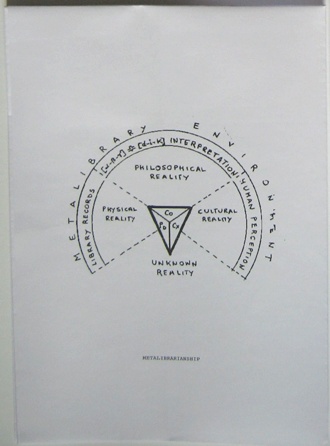A Catholic philosopher —

Related art —
The New York Times 's Sunday School today —
I prefer the three bricks of the Miracle Octad Generator —
The AND Publishing weblog page referred to in
a Sunday post has been changed to reflect the
source— my finite-geometry website— of pages
copied and altered by London artist Steve Richards
that are a large part of his contribution to the
AND Publishing Piracy Project.
The new version is as follows—

Note, however, that the cover page is a figure titled
by Richards "metalibrarianship" that has nothing
whatever to do with the concepts in the pages he copied
from my site, finitegeometry.org/sc.

Other pages within Richards's contribution to the
Piracy Project are similarly completely unrelated to
the content of my own site, which deals with geometry.
The image on the cover page also appears, it turns out,
on a website called intertwining.org.
At that site, it occurs in the following resume item:

The links in the resume item do not work,
but some background is available at a page titled
"Circularity, Practicality and Philosophy of Librarianship, or
The Making of 'The Nitecki Trilogy'" by Joanne Twining.
Other images in Richards's contribution to the Piracy Project also occur
in Twining's webpage "Dimensional Advances for Information Architecture."
I never heard of Twining or Nitecki before I encountered Richards's
Piracy Project contribution, and I do not wish to be associated
again in any way with Twining, with Nitecki, or with Richards.
This post was suggested by a book advertised
above A. Whitney Ellsworth's obituary in tonight's
online New York Times .
See also the following illustrations—
From this journal on June 1, 2008:
From artist Steve Richards on January 14, 2010:
My work has been pirated by an artist in London.
An organization there, AND Publishing, sponsors what it calls
"The Piracy Project." The artist's piracy was a contribution
to the project.
The above material now reflects the following update:
|
UPDATE of June 21, 2011, 10:00 PM ET: The organization's weblog (a post for 19th June) In this weblog, changes have been made to correct my "AND Publishing is not sponsored by the art school. |
As this post originally stated…
The web pages from the site finitegeometry.org/sc that
the artist, Steve Richards, copied as part of his contribution to
the AND Publishing Piracy Project have had the author's name,
Steven H. Cullinane, and the date of composition systematically removed.
See a sample (jpg, 2.1 MB).
Here is some background on Richards.
Yesterday's post Ad Meld featured Harry Potter (succeeding in business),
a 4×6 array from a video of the song "Abracadabra," and a link to a post
with some background on the 4×6 Miracle Octad Generator of R.T. Curtis.
A search tonight for related material on the Web yielded…
Weblog post by Steve Richards titled "The Search for Invariants:
The Diamond Theory of Truth, the Miracle Octad Generator
and Metalibrarianship." The artwork is by Steven H. Cullinane.
Richards has omitted Cullinane's name and retitled the artwork.
The author of the post is an artist who seems to be interested in the occult.
His post continues with photos of pages, some from my own work (as above), some not.
My own work does not deal with the occult, but some enthusiasts of "sacred geometry" may imagine otherwise.
The artist's post concludes with the following (note also the beginning of the preceding post)—

"The Struggle of the Magicians" is a 1914 ballet by Gurdjieff. Perhaps it would interest Harry.
Powered by WordPress